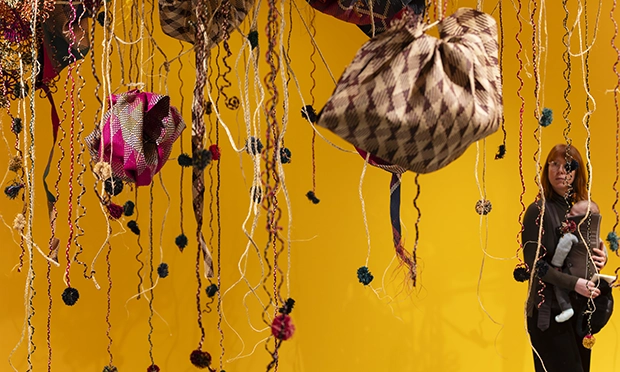Unravel, Barbican, exhibition review: ‘Expands our appreciation of textiles as art’

‘Variety and versatility’: A woman enjoys the exhibition. Photograph: Jemima Yong
Textiles are perhaps the most everyday thing you could imagine; they are on our backs, under our seats, and around many of the items we use daily.
Unsurprisingly, most of us tend to have a pretty utilitarian approach to things woven, sewed or knotted; the subversive potential of fabric is not something that is likely to spring immediately to mind.
Unravel, an exhibition at the Barbican, sets out to make us rethink our conceptions about fibre.
The show features 50 artists from around the world who have been working since the 1960s to explore the potential of threaded matter as a medium.
The materials they use are hugely varied, from traditional cotton and wool to jute, silk, hemp, and wire.

Cecilia Vicuña’s Quipu Austral, 2012. Copyright: Cecilia Vicuña / courtesy the artist and Lehmann Maupin. Photograph: Cecilia Vicuña
We see work that in fact has long roots, as people have throughout human history encoded messages in items they have made.
Many of those people have been women, making textiles the natural medium through which to probe the ways in which social roles are embedded in quotidian practices.
Subversive stitching by traditionally marginalised groups is a theme that stands out in the exhibition.
Małgorzada Mirga-Tas uses traditional quilting to link Roma narratives and art forms with concerns about oppression and victimisation.
Billie Zangewa’s silk collages figure sewing as female empowerment and a riposte to colonial impositions.
Cecilia Vicuña’s monumental sculptures of hanging wool invoke richly complex Andean indigenous traditions.

Blood in the Grass, 1966, by Hannah Ryggen. Copyright: Hannah Ryggen / DACS 2023
Photograph: Kode / Dag Fosse
Protest also features prominently; embroidered works by Cian Dayrit denounce exploitation of the natural environment in the Philippines.
Hannah Ryggen’s startling anti-Vietnam war tapestries pulse with colour and texture.
Faith Ringgold mixes media to depict the injustices of Black American experiences.
Given the variety and versatility of textiles, it would seem unremarkable that they should be used as media of art as well as craft.
This exhibition does much to expand our appreciation of the many of ways in which this has been accomplished.
We’re also left with a nagging disquiet at the relative absence of threaded works from the conventional artistic cannon.
Here’s hoping that Unravel will go some way toward changing that.
Unravel: The Power and Politics of Textiles in Art runs until 26 May at the Barbican Art Gallery, Barbican Centre, Silk Street, EC2Y 8DS.
